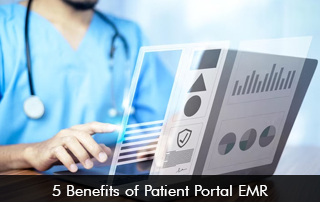It’s the age of patient engagement and empowerment and Patient Portal EMR Software helps patients feel engaged throughout their healthcare journey. According to a 2023 HIMSS Analytics Survey conducted in 2023, 90% of healthcare organizations offer their patients a patient portal platform but surprisingly only 60% of patients say they have used it. To increase patient portal adoption rates, providers must convey the prominent benefits that can be reaped using the robust patient engagement solution. This will encourage patients of all age groups to use the patient portal software to conveniently access their health records and communicate with care teams.
Key Features Present in a Top-Ranked Patient Portal EMR Software System
A variety of functions are often included in patient portal software, which is intended to facilitate communication between patients and healthcare professionals, increase access to medical records, and expedite administrative tasks. Key characteristics of Patient Portal EHR Software include:
- HIPAA-compliant Messaging Platform
- Appointment Scheduling
- Access to Medical Records such as lab results, immunizations, allergies, and lab results.
- Prescription Management
- Telemedicine Integration
- Billing and Payment Processing
- Educational Resources
- Appointment Reminders
- Mobile Accessibility
- Integration with Electronic Medical Records (EMR) Software
These elements help to create a comprehensive patient portal software system. These tools increase patient engagement, improve healthcare delivery, and streamline administrative work for both patients and healthcare providers.
Top 5 Advantages of Patient Portal Software System in 2024
Increased Patient Loyalty
Practices that want to boost patient loyalty in 2024 should make use of the patient portal software. According to David Clain of athenahealth software, the patient experience can be streamlined via patient portal technology which can boost patient loyalty.
Data from athenaResearch revealed interesting insights, that patient portal users are more prone to return to practice as compared to non-patient portal software users. It only makes sense to increase patient loyalty with an intuitive patient portal system.
Empowerment and Improved Self-Management
Patient Portal EMR Software offers educational information, prescription reminders, and tools to help patients take control of their health. This results in greater self-management of chronic illnesses and preventive treatment with increased medication adherence.
Better Revenue Cycle Management
When patients have the facility to pay online bills via the patient portal software system, it boosts patient satisfaction scores and even improves revenue cycle management. Payments can be collected faster and bills collected through the patient portal can increase greatly.
Cost Savings
Patient portal software can help healthcare providers and patients save money and it is always a top priority of practices to reduce costs. When a patient portal platform is implemented it can lower administrative costs, decrease duplicate tests, and enhance treatment plan adherence.
Improved Integration and Interoperability
The EHR software systems and other healthcare applications are integrated with the patient portal system. This enhances care coordination between healthcare providers and guarantees accurate and updated patient data across various platforms.
Importance of an Intuitive Patient Portal EMR Software
To promote active patient engagement and guarantee smooth communication between patients and healthcare providers, a user-friendly patient portal software system is essential. Its significance stems from its capacity to provide patients with convenient access to their medical records, schedules, and communication resources through an easy-to-use interface. A Patient Portal EHR Software that is easy to use can improve patient satisfaction by making it easier for users to navigate, lowering obstacles to receiving healthcare services, and promoting frequent interaction.







